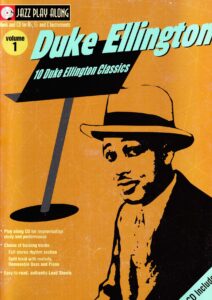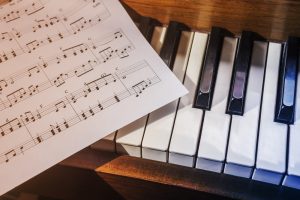Table of Contents
Come join us now, and enjoy playing your beloved music and browse through great scores of every level and styles!
Can’t find the songbook you’re looking for? Please, email us at: sheetmusiclibrarypdf@gmail.com We’d like to help you!
Duke Ellington It Don’t Mean A Thing (If It Ain’t Got That Swing) Piano sheet music, Noten, spartiti.
Best Sheet Music download from our Library.
Duke Ellington
Edward Kennedy “Duke” Ellington (April 29, 1899, Washington, DC, United States – May 24, 1974, New York, United States) was born into a family that never suffered financial hardship, as his father was a butler in a wealthy household and his mother came from a wealthy black family. In addition to an excellent bourgeois education, he received an air of aristocratic elegance that he would carry throughout his life, hence the nickname “Duke” given to him by his friends. His musical education began on his mother’s piano, and although he received lessons from two teachers, it would take him a long time to learn to read music. In 1919, he abandoned his studies in design and decoration, decided to marry a childhood friend, and pursued music as his career.

It was in 1921 when Duke Ellington formed his first and own group with local musicians, which he would call “The Duke’s Serenaders” first, and then the famous “The Washingtonians” with Elmer Snowden as bandleader. In 1923, they decided to move to New York. The experience was not very positive, but they managed to play for a few weeks in Wilbur Sweatman’s band, which performed at the Lafayette Theatre. After some trips back and forth between Washington and the Big Apple, they landed a contract at the Hollywood club. One night, Bix Beiderbecke heard them play, who attentively observed the sound of the “wa-wa” mute produced by trumpeter Bubber Miley and trombonist Charlie Irvis. That particular sound would be decisive in shaping Duke Ellington’s musical discourse.
In 1924, with his musical knowledge greatly improved, WHN, a local radio station, broadcast the show from the Hollywood club, now renamed the Kentucky Club. The band began to gain recognition and began receiving contracts in other cities near New York. Between 1924 and 1926, key musicians from Ellington’s orchestra joined the band, including, temporarily, clarinetist Sidney Bechet and baritone saxophonist Harry Carney, the first great specialist on that instrument in the history of jazz, who would remain with Ellington his entire life.
This is the orchestra that in 1927, with a solid formation, well shot and with its own sound, would make the great leap to fame when they were hired to play in the ‘Cotton Club’ of Harlem, a place run by the Gangster Owney Madden, since 1923 and that had become fashionable in New York to the point that was frequented by public exclusively white, people of money, money people New York There he was four years and when he left in 1931, he was covered with glory.
Between 1927 and 1945, after creating the “jungle style” for jazz, Duke Ellington and his orchestra reached the peak of their artistic and creative maturity. Duke Ellington’s orchestra in the 1940s was undoubtedly the one with the best soloists and most virtuoso instrumentalists of the time, and Down Beat magazine repeatedly ranked him, by popular vote, even above Benny Goodman’s. After the decline of big bands, Ellington was the only orchestra leader who never disbanded his own.
In the absence of contracts, he paid his musicians with royalties and used his orchestra to compose with and hear their music. But some of his soloists left between the late 1940s and early 1950s to pursue solo careers. The departure of Ben Webster, Barney Bigard, Tizol, and others was followed by a definitive departure in 1951, that of his friend, Johnny Hodges. The press, which had previously lavished praise on the orchestra, announced the demise of the orchestra almost daily.
In 1955, Johnny Hodges returned to the band, and Ellington breathed a sigh of relief. A number of musicians were added to the roster who would further expand the Ellington sound. Among the most notable additions were saxophonists Paulo Gonçalves and Jimmy Hamilton, clarinetist Russell Procope, trombonist Quenty Jackson, and trumpeters Cat Anderson and Clark Terry.
With these musicians and a certain amount of skepticism, Ellington was invited to perform at the 1956 Newport Jazz Festival. What happened that night is written in the annals of jazz. Duke Ellington pulled two songs, composed in 1937, “Diminuendo in Blue” and “Crescendo in Blue,” out of his creative hat and decided to play them together onstage, separating them simply with an interlude by Gonçalves.
And then the miracle happened. The saxophonist’s sweeping twenty-seven choruses, followed by pure jazz improvisation, driven by exemplary rhythms, turned the story on its head. Chairs flew over the heads of the astonished, roaring spectators, and the next morning, all the press headlined, “Ellington is back.”
From then on, the tours, concerts around the world, and recordings began. In the last ten years of his life, he dedicated himself to composing suites and sacred concerts. His life ended when cancer took his life on May 24, 1974. Ellington forever occupies the throne of the greatest creators of jazz, alongside Louis Armstrong and Charlie Parker. He is undoubtedly one of the greatest composers of the 20th century, regardless of the type of music one considers. His legacy is a cultural heritage that will always remain with us.
Sophisticated Lady / Solitude (Live At The Whitney Museum/1972)
Sophisticated Lady / Solitude (Live At The Whitney Museum/1972) · Duke Ellington Duke Ellington’s Finest Hour.
Almost at the end of his career, Duke Ellington was persuaded in three occasions to do a brief break with his big band and to give recitals in trio on that they were centering on his interpretation of the piano. The last occasion is included in this CD, which was thrown for the first time in 1995, and that gathers the teacher in a concert in Whitney Museum of New York. To one week of fulfilling his 73 birthdays, “Duke” keeps on being in full creative faculties.
Browse in the Library:
Or browse in the categories menus & download the Library Catalog PDF:
Duke Ellington discography
From Wikipedia, the free encyclopedia
This is the discography of recordings by Duke Ellington, including those nominally led by his sidemen (mainly in the 1930s and early 1940s), and his later collaborations (mainly in the 1960s) with musicians with whom Ellington had generally not previously recorded.
Below are listed 96 studio albums (including 1 box set and 5 EPs), 65 live albums (including 1 box set), and 235 compilations (including 17 box sets and 5 EPs) by the Duke.
